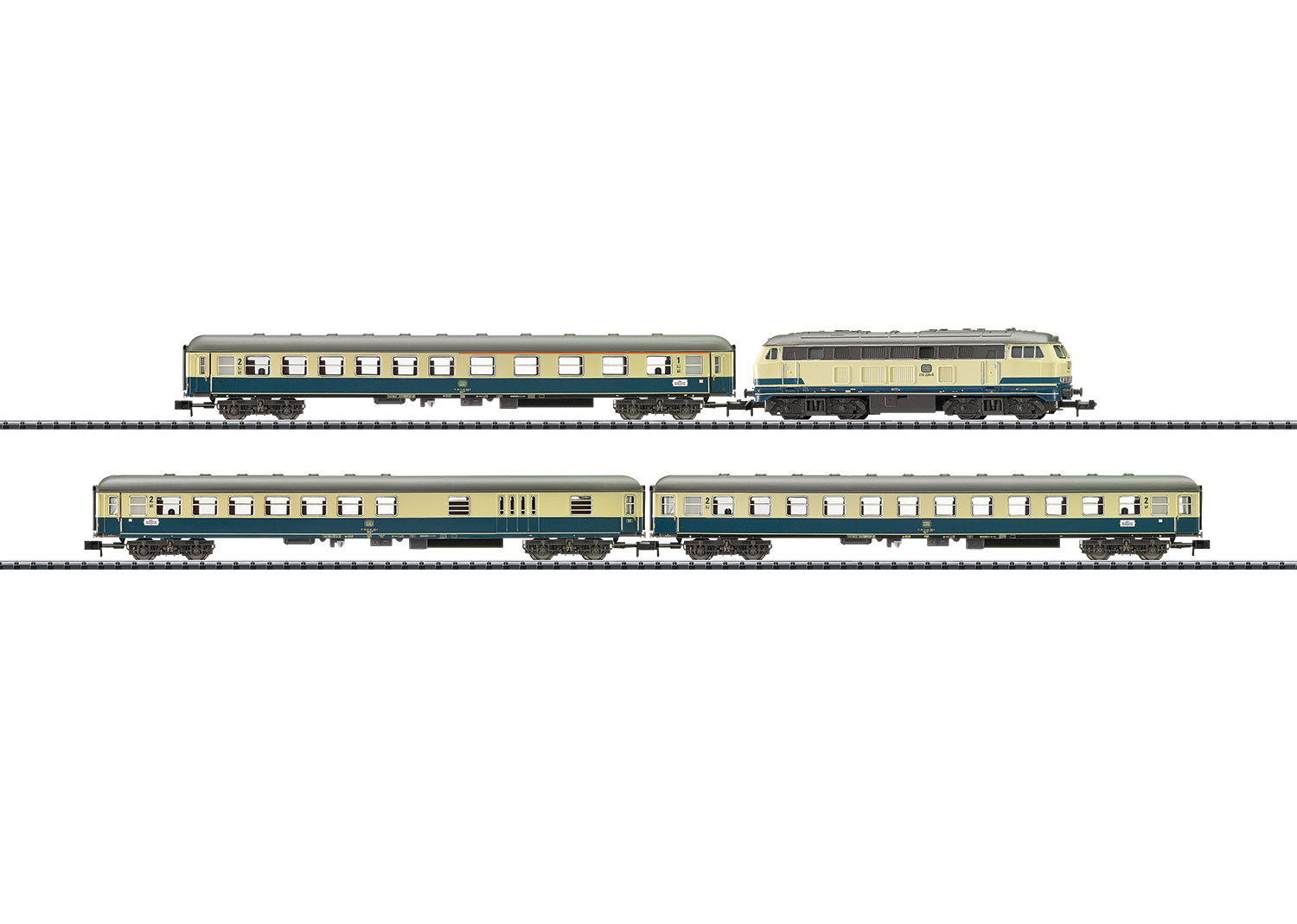Starter Set with a Passenger Train, Track Layout, and Locomotive Controller
Prototype: German Federal Railroad (DB) passenger train: German Federal Railroad (DB) class 216 diesel locomotive. B-B wheel arrangement. 3 different express train passenger cars in the ocean blue / ivory paint scheme.
Most Important Facts
| Article No. | 11137 |
|---|---|
| Gauge / Design type | Minitrix / |
| Era | IV |
| Kind | Starter Sets |
Check with your local dealer Find Dealer
-
Product description
Model: The locomotive has a 14-pin digital interface connector and a 5-pole motor. 4 axles powered. Traction tires. The headlights change over with the direction of travel. The cars have a close coupler mechanism. Total train length 595 mm / 23-7/16". Oval of track 94 x 44 cm / 38" x 18", station set with two curved turnouts and a passing siding as well as a switching set with a siding with an uncoupler track.
A locomotive controller, switched mode power pack, and connection hardware are included.
This set can be expanded with the 14301 large track extension set and with the entire Minitrix track program. 14934/14935 electric mechanisms can be installed in all of the turnouts. The 66616 LED lighting kit can be installed in the passenger cars.
Spare parts for our articles can be found here in our spare parts search.
-
Publications
- New Items 2014 - Main Catalog 2014/2015 - Main Catalog 2015/2016 - Main Catalog 2016/2017
-
Prototype information
"50 Years of the Class 216" (Production Series, until 1968 the Class V 160) The end of steam motive power becoming apparent as well as greater transportation services caused the DB at the end of the Fifties to order a general-purpose locomotive of medium performance (1,900 horsepower) within the framework of its expanded type program. The following were specified as design features: a single-motor, four-axle locomotive with trucks with diesel hydraulic power transmission, a maximum speed of at least 120 km/h / 75 mph as well as sufficient train heating for an express train with ten cars. During test runs with the ten prototypes, it was apparent that different components such as the universal shafts had been made too weak in their dimensions. This was improved with reinforced components during the manufacture of the regular production locomotives delivered starting in 1964. In addition, the ends of road number V 160 010 were simpler to manufacture and were adopted to save costs in the same area. Plans for welded lightweight steel construction of the ends of the locomotive were discarded. Between the two cabs insulated against noise was an engine room with the propulsion layout, cooling group, and oil-fired forced-circulation boiler for the train heating. The engine room was accessible by means of a side corridor. A Voith fluid transmission was used to transmit the power. It had to be newly developed for motors of this performance class. Since a heavy 1,900 horsepower motor also had to be installed during regular production of the locomotive, the locomotive's weight increased by about three tons. With a wheel load of 20 tons, the V 160 was no longer a practical candidate for use on branch lines. Since there were now enough of the V 100 available for this purpose, this was no longer a problem. By 1969 a total of 214 regular production class V 160 (from 1968 on: class 216) had been delivered by the firms Krupp, Henschel, Klöckner-Humboldt-Deutz (KHD), Krauss-Maffei, and Maschinenbau AG Kiel (MaK). Half of them were equipped for multiple unit operation. In time, there were improvements to combat the noise with insulation of the cabs, elastic mounting of the motor and installation of more efficient noise damping insulation. The regular production class 216 locomotives bade farewell in February of 2004 when the last five units were put into storage. Seven units were equipped with Scharfenberg couplers as the class 226 and earned a living as ICE tow locomotives. In addition, the steam generator for the Webasto train heating and the corresponding counterbalance weights had to be removed. The last two of the locomotives modified in this way were taken out of service in July of 2005. Several 216 locomotives began a second career on private railroads or with construction firms (chiefly in Italy).






